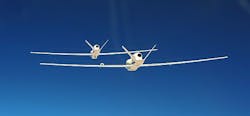Officials of the U.S. Defense Advanced Research Projects Agency (DARPA) will reveal details about the Collaborative Operations in Denied Environment (CODE) program from 9 a.m. to 4 p.m. on 11 April 2014 at 675 North Randolph St. in Arlington, Va. Those who would like to attend must register no later than 4 April 2014.
The industry briefings will be in advance of the release of a formal solicitation for the CODE program to enable UAVs to work together in teams and take advantage of the relative strengths of each participating unmanned aircraft.
The CODE program is to expand the mission capabilities of existing UAVs through increased autonomy and inter-platform collaboration. Collaborative autonomy has the potential to increase capabilities and reduce costs of today's UAVs by composing heterogeneous teams of UAVs that can capitalize on the capabilities of each unmanned aircraft without the need to duplicate or integrate capabilities into one UAV, DARPA officials say.
Related: UAV command, control & communications
Although today's UAVs have proven themselves in a wide range of missions, most current UAVs are not well matched to the needs of future conflicts, DARPA officials say.
Compared to today, future conflicts will be much less permissive, very dynamic, confront U.S. and allied forces with more dangerous threats, and involve contested electromagnetic spectrum and relocatable targets, researchers say.
In these future conflicts UAVs could use collaboration algorithms to help each other with tasks like geo-locating targets with long-distance sensors, as well as guiding less-capable UAVs to within their sensor ranges.
Collaboration algorithms also could help UAVs work together to provide multi-modal sensors and diverse observation angles to improve target identification, transmit important information through the network, provide navigational aide to low-tech or damaged UAVs, and protect each other by overwhelming defenses.
Related: Hunter-Killer UAVs to swarm battlefields
Goals of the CODE program are to develop and demonstrate the value of collaborative UAV autonomy in tactical situations; rapidly bring that capability to the warfighter; develop ways to expand the range of collaborative UAV missions; and help researchers contribute to collaborative autonomy technologies.
DARPA researchers primarily are interested in four areas. First, they want to develop autonomy for the subsystems, equipment, and flight trajectories of UAVs working alone under routine and abnormal conditions.
Second, DARPA researchers want to develop interfaces to enable mission commanders to maintain situational awareness, dynamically define mission objectives and problems, monitor progress, and provide important inputs as necessary to several UAVs simultaneously.
Then researchers want to develop UAV team-level autonomy, including developing and maintaining a common representation of the operating environment to help formulate collaborative action plans that make the most of the strengths of each participating UAV.
Lastly, DARPA wants to develop an open architecture for UAV collaboration to help commanders maintain situational awareness and control of the UAVs in electronic jamming, poor communications, bad weather, and other adverse conditions.
The morning overview session of the 11 April industry briefings is unclassified but ITAR restricted. The classified afternoon sessions will cover specific capabilities being sought. Companies interested may present information on relevant research to promote teaming.
Those attending the morning briefings must be U.S. citizens or permanent residents, while those at the afternoon sessions must have secret security clearances. Attendance is limited to two people per organization, and there is room only for 150 attendees.
Those who would like to attend must register no later than 4 April 2014 online at www.schafertmd.com/darpa/tto/code.
Email questions or concerns to the DARPA CODE program manager, Jean-Charles Lede at [email protected]. More information is online at https://www.fbo.gov/spg/ODA/DARPA/CMO/DARPA-SN-14-28/listing.html.



